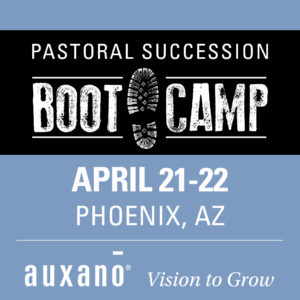I’ll never forget my very first observation about succession planning.
Succession planning is personal long before it becomes tactical.
This was the “big idea” God used to get my attention in this area. A mentor of mine trusted me enough to open up and talk through the fears he had about his eventual retirement. At the time he was over 10 years away from retiring. The conversation was personal and left a deep impression.
Since that moment, this principal has become a primary filter for serving leaders in seasons of transition.
I like what Marshall Goldsmith wrote in his book Succession, Are You Ready.
“Academic” literature generally ignores the fact that CEO’s – and their successors – are human beings. Very little of what is written deals with the “soft” personal issues like relationships, self-interest, ego, or (God forbid) feelings! – Preface: Memo to the CEO, page XIV
His book is written to those in the “C” Suite, but his comments apply to leaders in both secular and sacred nonprofit organizations.
To help you process the personal side of succession planning, here are five biblical passages to read and reflect upon. Take one at a time. Read them slow and in context. Reflect on specific, personal applications. Record your thoughts in a journal. Pray with your spouse.
A Pattern to Follow – Numbers 8:23-26
This is the only passage in scripture that speaks directly to the topic of retirement based transitions. It is God’s instruction to Moses on how to manage the Levite work force as they age. The insights in this passage stand as a stark contrast to how retirement is viewed by those of us living in a western, capitalistic culture.
A Lament to Wrestle With – Ecclesiastes 2:18-21
It seems understandable, natural even, for the leaders that invested their lives to build something would lament the fact that someone else would eventually step into their shoes. Solomon’s concerns expressed in this passage seem to resonate in the hearts of many leaders today.
A Change in Identity – Deuteronomy 3:23-29
Mount Pisgah marked a profound shift in Moses’ identity as leader. Climbing the mountain, his primary identity as leader was centered around leading Israel into Canaan. Coming down, his primary focus was preparing Joshua and Israel for the day he would no longer be with them. A careful look at verses 23-26 reveal this had been something Moses struggled with for quite some time.
A Desire for the People – Numbers 27:12-23
Numbers 27:12-23 and Deuteronomy 3:23-29 are parallel passages that provide different insights into the same moment – God confronting Moses with his need to implement a succession plan. Even though Moses experienced great frustration in leading Israel, this passage spotlights his genuine concern for their well-being. He was concerned more for their future in his absence than his personal legacy.
A Passion to Protect – 2 Kings 20:16-19
To truly appreciate this specific passage you must read the full account – 2 Kings 18 – 21:9. Hezekiah’s story stands as a profound example of how zeal and passion can diminish over time. At 25 he had the audacity to destroy the Bronze Serpent that Moses build some 700 years prior (2 Kings 18:4). By the end of his career he was willing to trade his personal comfort for the future of Israel. His zeal was gone.
As you study this passage pay special attention to 2 Kings 20:6 and 2 Kings 21:1. God extended Hezekiah’s life 15 years and moved the nation into a season of peace and prosperity. It was during this time his son, his successor, was born. Manasseh was 12 when he became King. The son’s perspective of God was shaped by his father’s leadership while in a season of peace. He never knew his father as man that depended on God. One can’t help but wonder how much that played into his attitude towards God during his tenure as King.
A Prayer of Reflection – 1 Chronicles 29:10-19
This is the last, or one of the last, recorded prayers of King David. Unlike Hezekiah, David’s passion for the Lord burned bright to the very end. It is not the words of this prayer that make it unique. It is not so different that many other prayers of reflection that can be found throughout history. No, what makes this prayer special is the point in David’s life in which he uttered it. Indeed, there are certain prayers that can only be voiced by those who have given their life, their length of days, to the service and glory of God.
I pray these passages would serve as both a source of encouragement and warning as you reflect upon the reality of your eventual transition.
Succession planning isn’t the last great thing you will do as a leader. Succession planning is the gateway to your greatest season of influence.
Let me know if there is any way we can serve you in this season. Let’s start a conversation.

Tags: Will Heath, succession planning
|
What is MyVisionRoom? > | Back to Leadership >























